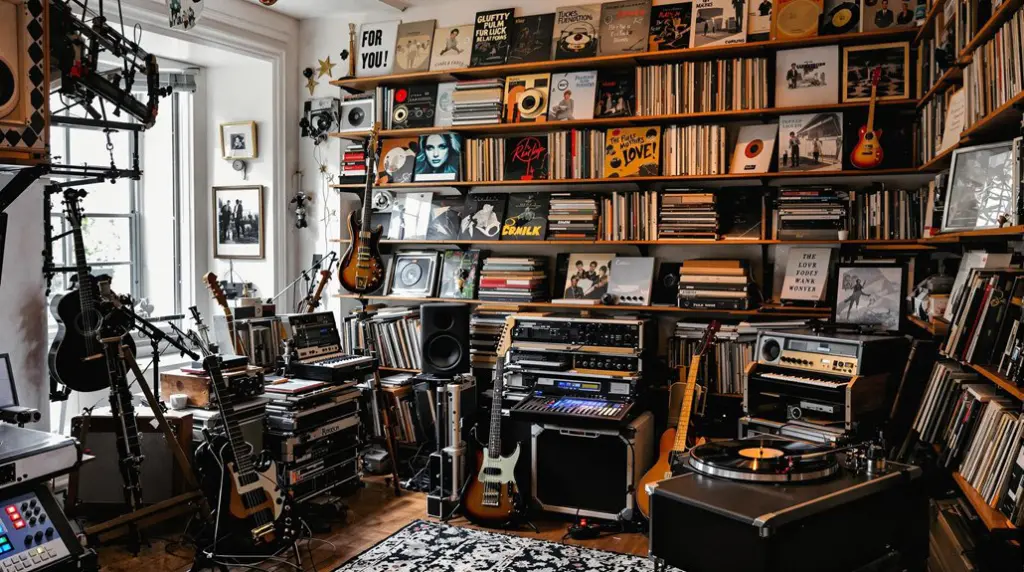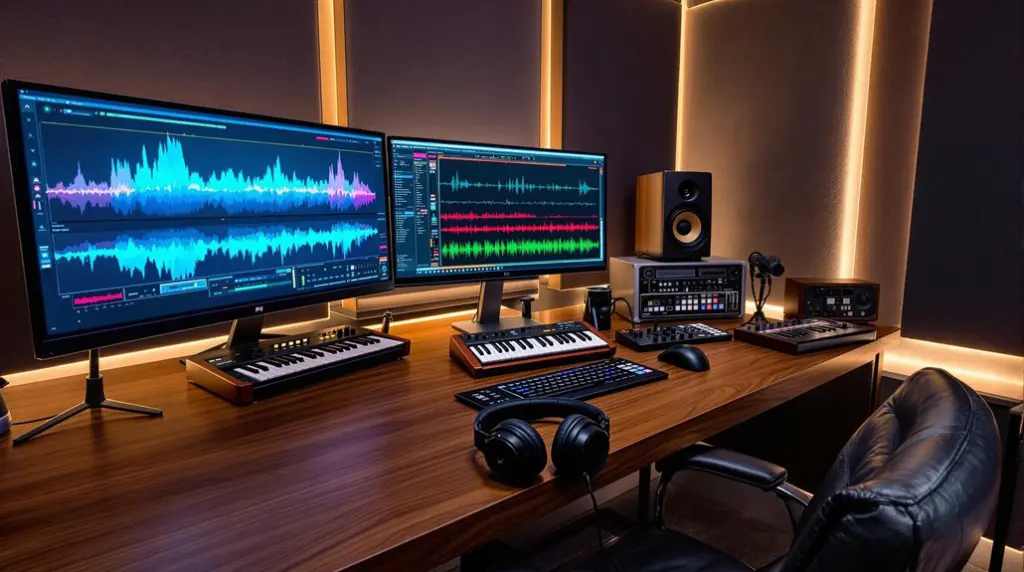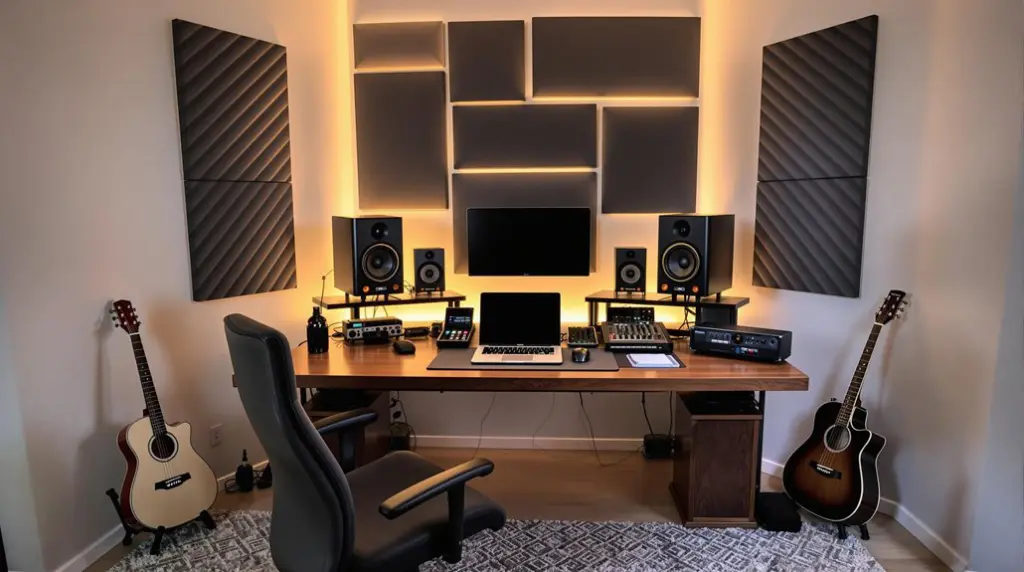To perfectly EQ your guitar, start by understanding the frequency range, which spans from 82 Hz to 5 kHz. Adjust your amp settings for a flat response baseline. Next, apply high-pass filters to eliminate muddiness below 100-150 Hz and low-pass filters to cut unwanted fizz above 5 kHz. Use bell filters to enhance clarity at 800 Hz while dipping around 1.5 kHz to reduce harshness. Finally, embrace experimentation with various settings to discover unique tonal qualities. This structured approach guarantees ideal sound clarity and character, revealing further nuances as you continue to refine your technique.
Key Takeaways
- Begin with all EQ knobs at maximum for a flat response, then adjust to shape your tone effectively.
- Use high-pass filters to eliminate low-end muddiness, focusing on frequencies above 100-150 Hz.
- Apply bell filters around 800 Hz to enhance clarity without introducing boxiness in your sound.
- Dip frequencies around 1.5 kHz to reduce unwanted harshness and improve overall tonal quality.
- Regularly assess your adjustments on different playback systems to ensure clarity and balance in your mix.
Understanding EQ Basics
The art of equalization (EQ) serves as a fundamental pillar in shaping the sonic identity of electric guitars. EQ involves adjusting the loudness of specific frequencies to enhance or reduce tonal characteristics, vital for sculpting your sound.
Electric guitars typically produce frequencies ranging from 82 Hz to 5 kHz, with low frequencies contributing warmth, mid frequencies defining character, and high frequencies adding brightness and clarity.
Employing techniques such as high pass filters can effectively remove low-end muddiness, while bell filters allow you to boost or cut specific ranges, like enhancing clarity around 800 Hz or mitigating harshness between 1.5 kHz and 4 kHz. Mastery of EQ requires critical listening and experimentation, as each guitar and context demands unique adjustments. Additionally, using low-pass filters can help refine audio quality effectively by addressing inaudible frequencies in your guitar sound.
Adjusting Your Amp Settings
To effectively adjust your amp settings, begin by setting all EQ knobs to their maximum position, as this establishes a flat response that serves as a baseline for subsequent modifications. This approach enables you to understand how your tone adjustments will impact the overall sound. Be cautious with high EQ settings, as they can lead to early saturation of the amplifier, compromising a cleaner tone. Experiment with initial tone adjustments directly from the amp prior to adding effects to assess your guitar’s raw sound effectively. Additionally, familiarize yourself with the EQ principles of your specific amp model to avoid common tonal mistakes. Understanding frequency ranges can further enhance your ability to sculpt your desired tone.
| EQ Setting | Effect on Tone |
|---|---|
| Bass (10) | Increased low-end presence |
| Mid (10) | Enhanced body and warmth |
| Treble (10) | Brightness and clarity |
| Presence (10) | Crisp articulation |
Fine-Tuning With Filters
Achieving ideal guitar tone extends beyond adjusting amp settings; it necessitates the precise application of filters to sculpt the frequency response.
Implementing a high-pass filter to roll off low frequencies below 100-150 Hz considerably reduces muddiness, allowing the guitar to coexist more harmoniously with the bass.
Conversely, applying a low-pass filter to cut high frequencies between 5 kHz and 10 kHz eliminates unwanted fizz and harshness, enhancing tonal smoothness.
Adjusting the Q setting around 1.0 effectively manages boosts or cuts in specific frequency ranges without adversely impacting adjacent tones.
Additionally, utilizing a peak filter with a slight dip at 1.5 kHz removes the “vacuum cleaner” sound, while experimenting with steeper slopes (e.g., 24 dB/octave) can aggressively tame problematic frequencies. Regular assessment of mix clarity on different playback systems is essential for achieving a clean mix.
Using EQ in Mixing
Effective use of EQ during the mixing process is paramount for achieving a balanced and polished sound.
Begin by applying a high-pass filter to eliminate unnecessary low frequencies below 100 Hz, mitigating muddiness and allowing the guitar to coexist harmoniously with the bass.
Utilize bell filters to boost frequencies around 800 Hz for enhanced clarity, while avoiding excessive resonance that may introduce boxiness.
To address unwanted harshness, dip frequencies around 1.5 kHz with a Q of 1.0, preventing any masking of the guitar’s character.
Finally, roll off high frequencies between 5 kHz and 10 kHz using a low-pass filter to reduce fizz, ensuring the guitar retains brightness without compromising clarity within the context of the full mix. Additionally, employing surgical EQ cuts can effectively isolate and remove any resonant problem frequencies, further enhancing the overall clarity of the guitar sound.
Experimenting for Unique Tones
Exploring the nuances of EQ can reveal a myriad of unique tones for guitarists, allowing them to tailor their sound to match their individual playing style and musical context.
To achieve this, it is essential to experiment with various frequencies, employing high-pass filters to eliminate low-end muddiness below 100-150 Hz. Engaging in trial and error with frequency adjustments can enhance tonal characteristics; for instance, a boost around 5 kHz adds sparkle to the guitar sound.
Additionally, understanding amp EQ settings is vital, as lowering knobs cuts specific frequencies for clarity. Through critical listening during the EQ process, guitarists can develop a deeper connection with their instrument and discover distinctive tones that resonate with their artistry. Furthermore, utilizing EQ techniques can help to eliminate conflicting frequencies, enhancing the overall tonal quality of the guitar.
Frequently Asked Questions
What Is the Best Eq for Guitar?
Ideal EQ for guitars involves strategic equalization techniques across frequency ranges, considering tone shaping based on genre preferences. Key settings differ for acoustic versus electric guitars, with attention to common mistakes and gear recommendations for studio mixing and live performance.
How Can I Make My Guitar Sound Perfect?
To achieve a perfect guitar tone, focus on sound dynamics through frequency balance, pickup selection, string gauge, amp settings, and effects pedals. Additionally, refine playing technique and consider room acoustics for ideal tonal range.
How Do I Get the Cleanest Tone on My Guitar?
To achieve a clean tone on your guitar, optimize amp settings, select appropriate pickups, and configure guitar frequencies within the signal chain. Incorporate reverb effects and guarantee sound isolation, while considering tonewoods impact and playing technique for enhanced tone clarity.
How Do You Set up a Guitar Perfectly?
To achieve a perfect guitar setup, meticulously adjust string height, pickup settings, and intonation. Assess neck relief, bridge height, and nut slots while ensuring action measurement and electronics check for ideal tuning stability and overall performance.
Conclusion
Achieving an ideal equalization (EQ) for guitar requires a systematic approach, beginning with a solid understanding of EQ fundamentals and amp settings. The application of filters allows for fine-tuning, enhancing the overall sound quality. During the mixing process, effective use of EQ can considerably impact the clarity and presence of the guitar. Finally, experimentation with various settings can yield unique tonal characteristics, contributing to a more distinct and tailored sound, thereby elevating the overall musical composition.




